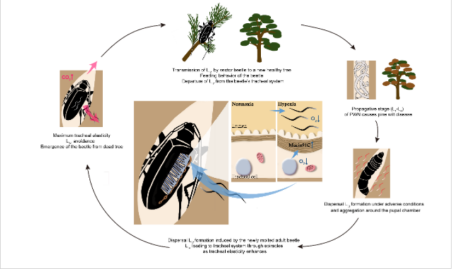Academic Trends of "Revitalizing Science and Technology":
eLife: Professor Sun Jianghua's Team Reveals the Mechanism that the Trachea of the Vector Longicorn Beetle Carries Hundreds of Thousands of Bursaphelenchusxylophilus (PWN)
Bursaphelenchusxylophilus (PWN), the main pathogenic factor of pine wilt disease, originated from North America and then invaded Asia and Europe, causing devastating damage to the forest ecosystem in the invaded areas. PWNs rely on vector insects for natural transmission, and the loading capacity of vector longicorn beetles to PWNs determines the transmission efficiency. Trachea is the main part of vector longicorn beetles to carry PWNs. A single beetle can harbor on average 15,000 and up to 280,000 PWNs in its tracheal system. However, how the tracheal system of longicorn beetles tolerates a large number of PWNs is still an unresolved problem.
Recently, Hebei University, in conjunction with the team of Institute of Zoology, Chinese Academy of Sciences, revealed the internal mechanism that Monochamus alternatus can carry a large number of PWNs. In this study, it was found that the oxygen content in the tracheal tubes of Monochamus alternatus decreased with the increase of the number of nematodes, and when it exceeded 10,000, significant hypoxia stress will emerge. At the same time, carrying more than 10,000 PWNs or treating longicorn beetles with hypoxia can enhance tracheal elasticity and thickened the apical extracellular matrix (aECM) of the tracheal tubes of longicorn beetles. In addition, transcriptome and gene structure analysis showed that Muc91C, a resilin-like mucin protein, was up-regulated by at least 7 times in the trachea of longicorn beetles carrying nematodes. The protein has a tandem repeat sequence rich in glycine and proline, which is highly similar to elastin in Drosophila melanogaster and Anopheles gambiae. Tissue immunofluorescence experiments showed that Muc91C was located between chitin spiral filament layer and tracheal cell layer. And further RNA interference experiments showed that the ability of longicorn beetles to carry PWNs decreased after down-regulation of Muc91C, indicating that Muc91C was the main regulatory factor mediating hypoxia-induced tracheal elasticity enhancement of Monochamus alternatus. The increase of tracheal elasticity provides more space for PWNs, enhances ventilation, improves the adaptation of longicorn beetles to hypoxia, and ensures the loading capacity of Monochamus alternatus to PWNs, thus promoting the spread of PWNs. This study clarified a new mechanism that PWNs used hypoxia signal to induce the change of tracheal mechanical force of Monochamus alternatus to shape the carrying capacity of vector insects, and identified a new extracellular matrix protein molecule related to the mechanical force of tubular organs, which provided a new idea for targeted control of pathogen transmission.

Pattern diagram of feedback regulation mechanism of PWNs being carried by hypoxia signal
The paper was published online in eLife on March 30, 2023. Tang Xuan, doctoral candidate of Institute of Zoology, Chinese Academy of Sciences, Zhou Jiao, assistant researcher of Institute of Zoology, Chinese Academy of Sciences, and Tuuli-Marjaana Koski, postdoctoral fellow of Hebei University are the co-first authors of the paper, Professor Sun Jianghua of Hebei University is the correspondent author, and Zhao Lilin, researcher of Institute of Zoology, Chinese Academy of Sciences is the co-correspondent author. The paper was supported by the Basic Science Center Program of National Natural Science Foundation of China, National Key Research and Development Program of China, the General Program of National Natural Science Foundation of China and other programs.
Paper information:
Tang X, Zhou J, Koski TM, Liu SY, Zhao LL, Sun JH. Hypoxia-induced tracheal elasticity in vector beetle facilitates the loading of wood nematode.eLife, 2023, 12: e84621
Original link:
https://elifesciences.org/articles/84621